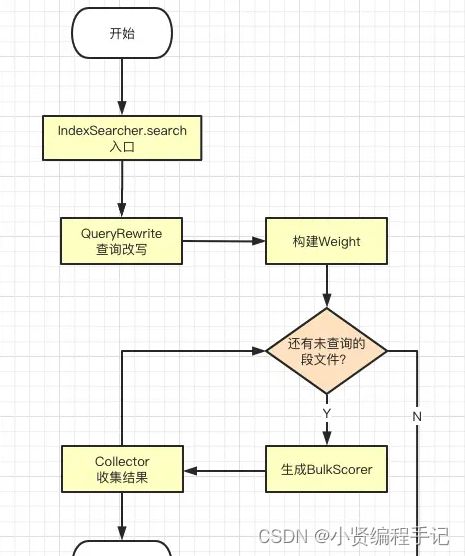- 400多个免费在线编程与计算机科学课程
zhufafa
基础理论课程理论计算机基础免费
来源:medium作者:DhawalShah五年前,麻省理工学院和斯坦福大学等学校首先向公众开放免费的在线课程。如今,全球有700多所学校创造了数以千计的免费在线课程。从入门到精通系列,是作者通过ClassCentral的课程数据库整理的400多个免费在线课程的简介和链接(来源于ClassCentral,一个在线课程搜索引擎),根据课程难度分为入门、进阶和高阶三大类,每门课程还有星级评分(统计自C
- 使用 DeepSeek R1 和 Ollama 开发 RAG 系统 使用 DeepSeek R1 和 Ollama 构建强大的 RAG 系统。了解开发智能 AI 解决方案的设置过程、最佳实践和技巧。
知识大胖
NVIDIAGPU和大语言模型开发教程人工智能deepseekollama
简介DeepSeekR1和Ollama提供了用于构建检索增强生成(RAG)系统的强大工具。本指南介绍了使用这些技术开发RAG应用程序的设置、实施和最佳实践。为什么RAG系统会改变游戏规则检索增强生成(RAG)系统结合了搜索和生成AI的优点,可实现精确且准确的情境感知响应。借助DeepSeekR1和Ollama等工具,创建RAG系统不再令人生畏。无论您是构建聊天机器人、知识助手还是AI驱动的搜索引擎
- Elasticsearch搜索引擎存储:从原理到实践的全景解析
Python×CATIA工业智造
搜索引擎elasticsearch大数据
引言在大数据时代,数据规模呈指数级增长,传统数据库的模糊查询、实时分析能力逐渐成为瓶颈。Elasticsearch(简称ES)凭借其分布式架构、实时搜索和灵活的数据分析能力,成为企业级搜索与存储的核心引擎。截至2025年,ES在全球日志分析、电商搜索、实时监控等场景的市场占有率超过60%。本文将从存储架构、核心技术、应用场景及优化策略四个维度,深入解析Elasticsearch的设计哲学与实践价值
- Elasticsearch混合搜索深度解析(下):执行机制与完整流程
GeminiJM
ES学习笔记elasticsearchjenkins大数据
引言在上篇中,我们发现了KNN结果通过SubSearch机制被保留的关键事实。本篇将继续深入分析混合搜索的执行机制,揭示完整的处理流程,并解答之前的所有疑惑。深入源码分析1.SubSearch的执行机制1.1KnnScoreDocQueryBuilder的实现KNN结果被转换为KnnScoreDocQueryBuilder,这个类负责在查询阶段重新执行KNN搜索://server/src/main
- SkyWalking + Logstash全链路追踪系统详细实施方案
@淡 定
skywalking
SkyWalking+Logstash全链路追踪系统详细实施方案一、系统架构与数据流向核心流程:数据采集:SkyWalkingAgent埋点收集调用链路数据日志增强:应用程序通过MDC注入TraceID日志收集:Logstash采集应用日志并发送至Elasticsearch数据存储:SkyWalking指标数据与日志数据分别存储可视化分析:SkyWalkingUI展示链路追踪,Kibana分析日志
- 自建ELK vs 云商日志服务:成本对比分析
亲爱的非洲野猪
elk
在当今数据驱动的时代,日志管理已成为企业IT基础设施中不可或缺的一部分。面对日益增长的日志数据,许多团队都在纠结:是自建ELK(Elasticsearch、Logstash、Kibana)堆栈,还是直接使用云服务商提供的日志服务?本文将从成本角度对这两种方案进行详细对比分析。自建ELK方案成本分析1.硬件/基础设施成本服务器成本:至少需要3个节点(生产环境推荐)实现高可用中等规模部署:3台16核6
- 【spring boot】三种日志系统对比:ELK、Loki+Grafana、Docker API
ladymorgana
日常工作总结springbootelkgrafana
文章目录**方案1:使用ELK(Elasticsearch+Logstash+Kibana)****适用场景****搭建步骤****1.修改SpringBoot日志输出****2.创建DockerCompose文件****3.配置Logstash****4.启动服务****方案2:使用Loki+Grafana****适用场景****搭建步骤****1.修改SpringBoot日志驱动****2.配
- Semantic text 就是那么强大,还附带一包( BBQ )薯片!配有可配置的分块设置和索引选项。
Elastic 中国社区官方博客
ElasticsearchAI大数据elasticsearch搜索引擎全文检索人工智能ai图搜索
作者:来自ElasticKathleenDeRusso语义文本搜索现在可以自定义,支持可配置的分块设置和索引选项,用于自定义向量量化,使semantic_text在专业用例中更强大。Elasticsearch拥有大量新功能,帮助你为你的用例构建最佳搜索解决方案。深入查看我们的示例笔记本以了解更多信息,开始免费云试用,或者立即在本地机器上体验Elastic。随着Elasticsearch8.18和9
- Elasticsearch 高可用实战:架构设计与场景化解决方案
辣呼呼的哈哈
Elasticsearch入门到精通elasticsearchwpf大数据全文检索搜索引擎restfuljava
Elasticsearch高可用实战:架构设计与场景化解决方案本文深入探讨Elasticsearch在高并发、大数据量场景下的高可用架构设计,结合电商搜索、日志分析等真实案例,提供可落地的技术方案与Java实现。一、高可用架构设计原则1.分布式架构核心要素客户端负载均衡层协调节点数据节点-分片1数据节点-分片2数据节点-分片3副本分片副本分片副本分片2.高可用黄金法则冗余设计:至少3节点集群+1副
- Elasticsearch RESTful API入门:基础搜索与查询DSL
辣呼呼的哈哈
Elasticsearch入门到精通elasticsearchrestful大数据搜索引擎全文检索springboot
ElasticsearchRESTfulAPI入门:基础搜索与查询DSL本文为Elasticsearch初学者详细解析RESTfulAPI的核心操作与查询DSL语法,包含大量实战示例及最佳实践。一、Elasticsearch与RESTfulAPI简介Elasticsearch(ES)作为分布式搜索分析引擎,其RESTfulAPI是与集群交互的核心方式。通过HTTP协议实现:✅索引文档的CRUD操作
- Elasticsearch入门(二):document数据格式 、简单的es restful api
m0_50134014
Elasticsearchelasticsearchjava
目录一、document数据格式1.1面向文档的搜索分析引擎1.1.1对象数据存储到数据库中1.1.2对象数据存储到ES中二、电商网站商品管理案例背景介绍2.1简单的集群管理2.1.1快速检查集群的健康状况:`GET/_cat/health?v`2.1.2快速查看集群中有哪些索引:`GET/_cat/indices?v`2.1.3创建索引:`PUT/test_index?pretty`2.1.4删
- Elasticsearch RESTful API入门:全文搜索实战(Java版)
辣呼呼的哈哈
Elasticsearch入门到精通elasticsearchrestfuljava大数据搜索引擎全文检索
ElasticsearchRESTfulAPI入门:全文搜索实战(Java版)本文结合Java客户端API,深入讲解Elasticsearch全文搜索的实现。包含10+个实战示例及对应的Java代码,涵盖match、multi_match、高亮显示等核心功能。一、环境准备1.添加Maven依赖org.elasticsearch.clientelasticsearch-rest-high-level
- 【Elasticsearch】function_score
risc123456
Elasticsearchelasticsearch
如果你希望在Elasticsearch查询中降低某些特定`id`的文档评分,可以通过`function_score`查询结合`script_score`函数来实现。`script_score`允许你使用自定义脚本对文档的评分进行调整。以下是一个示例,展示如何降低某些特定`id`的文档评分:示例场景假设我们有一个索引`my_index`,其中包含一些文档,每个文档都有一个`id`字段。我们希望降低某
- Elasticsearch RESTful API入门:索引的增删改查完全指南
辣呼呼的哈哈
Elasticsearch入门到精通elasticsearchrestful大数据java架构搜索引擎全文检索
ElasticsearchRESTfulAPI入门:索引的增删改查完全指南本文专为Java开发初学者设计,将手把手教你掌握Elasticsearch索引的核心操作一、环境准备与基本概念1.1安装Elasticsearch(Windows版) 1.访问官网下载ZIP包 2.解压后进入bin目录,双击elasticsearch.bat启动 3.验证安装:浏览器访问http://localhost
- 百度搜索下拉框,下拉菜单怎么做?如何刷?
mt_187
日常记录技术收藏html5
搜索下拉菜单反馈性关键词是用户在搜索时与搜索引擎的第一步互动,在互动过程中,搜索引擎的反馈关键词不断调整来满足用户的个性需求。搜索下拉框存在的下拉词,每天的点击浏览量都很高,这意味着很多企业都在抢这个位置,在网民搜索自己的行业主关键词时,下拉中的词条是行业关键词和自己品牌词或其他营销类词的整体呈现。搜索下拉框菜单怎么做?如何刷?在本篇文章中您将会了解到以下信息。第一部分搜索下拉框菜单原理第二部分怎
- 恒创科技:香港站群服务器做seo站群优化效果如何
海外空间恒创科技
科技服务器运维
香港站群服务器做SEO站群优化效果如何?在当前搜索引擎优化竞争日益激烈的环境下,越来越多的企业开始关注站群策略这一高效的SEO手段。作为亚洲重要的网络枢纽,香港站群服务器因其独特优势,正成为实施SEO站群优化的热门选择。本文将客观分析香港服务器在SEO站群优化中的实际效果,帮助您做出明智的技术选型决策。香港站群服务器的先天优势:地理位置和网络基建香港站群服务器就像个“黄金地段”的商铺——背靠中国大
- 哪家香港站群服务器比较好用?
海外空间恒创科技
站群服务器服务器香港站群服务器
面对鱼龙混杂的服务商市场,哪家的香港站群服务器真正稳定?毕竟搞站群最怕的就是服务器抽风,轻则掉排名,重则客户跑光光。今天咱就重点聊聊哪家香港站群服务器比较好用?一般来说,在选择香港站群服务器提供商时,稳定性、IP资源、网络质量以及售后服务是关键考量因素。1.服务器的稳定性服务器频繁宕机或网络波动会导致站群网站无法访问,不仅影响用户体验,还会导致搜索引擎排名下滑,甚至被降权。稳定的服务器环境利于搜索
- 知识图谱系列(2):知识图谱的技术架构与组成要素
程序员查理
#知识图谱知识图谱架构人工智能AIAgentRAG
1.引言知识图谱作为一种强大的知识表示和组织方式,已经在搜索引擎、推荐系统、智能问答等多个领域展现出巨大的价值。在之前的上一篇文章中,我们介绍了知识图谱的基础概念与发展历程,了解了知识图谱的定义、核心特征、发展历史以及在AI发展中的地位与作用。要深入理解和应用知识图谱,我们需要进一步探索其内部的技术架构和组成要素。知识图谱不仅仅是一个简单的数据结构,而是一个复杂的技术体系,涉及知识的表示、存储、查
- Spring AI:Tool Calling
虾条_花吹雪
SpringAIaijava
工具调用(也称为函数调用)是人工智能应用程序中的一种常见模式,允许模型与一组API或工具交互,以增强其功能。工具主要用于:信息检索。此类工具可用于从外部源(如数据库、web服务、文件系统或web搜索引擎)检索信息。目标是增强模型的知识,使其能够回答否则无法回答的问题。因此,它们可用于检索增强生成(RAG)场景。例如,一个工具可用于检索给定位置的当前天气,检索最新的新闻文章,或查询数据库中的特定记录
- !LangChain自定义代理开发深度解析(44)
Android 小码蜂
测试专栏langchainmicrosoft.net
LangChain自定义代理开发深度解析一、LangChain代理基础架构1.1代理核心概念LangChain中的代理(Agent)是一种能够根据工具调用和对话历史自主决策的智能体。它通过以下核心机制实现智能交互:工具调用:代理可调用外部工具(如搜索引擎、计算器等)获取实时信息对话历史管理:维护多轮对话上下文,支持状态追踪决策逻辑:基于LLM生成决策,判断是否需要调用工具或直接回答1.2代理核心组
- !LangChain工具选择与调用策略深入解析(42)
LangChain工具选择与调用策略深入解析一、LangChain工具概述1.1工具的定义与作用LangChain中的工具(Tool)是用于扩展语言模型能力的核心组件,它允许开发者将外部功能或资源集成到基于语言模型的应用中。工具的本质是封装了特定功能的可调用单元,例如调用搜索引擎获取实时信息、操作数据库执行查询、调用文件系统读取数据等。通过工具,LangChain能够弥补语言模型自身能力的局限,使
- ! LangChain工具选择与调用策略深入解析(41)
Android 小码蜂
测试专栏langchain数据库服务器
LangChain工具选择与调用策略深入解析一、LangChain工具概述1.1工具的定义与作用LangChain中的工具(Tool)是用于扩展语言模型能力的核心组件,它允许开发者将外部功能或资源集成到基于语言模型的应用中。工具的本质是封装了特定功能的可调用单元,例如调用搜索引擎获取实时信息、操作数据库执行查询、调用文件系统读取数据等。通过工具,LangChain能够弥补语言模型自身能力的局限,使
- Docker快速单点部署Elasticsearch
❀͜͡傀儡师
dockerelasticsearch
x86架构dockerpullregistry.cn-hangzhou.aliyuncs.com/qiluo-images/elasticsearch:8.17.4arm架构dockerpullregistry.cn-hangzhou.aliyuncs.com/qiluo-images/linux_arm64_elasticsearch:8.17.43、elasticsearch安装mkdir-p
- ES 压缩包安装
思静鱼
#elasticsearchelasticsearch大数据
以下是Elasticsearch(ES)通过.tar.gz压缩包安装的详细步骤(适用于Linux/macOS系统):1.准备工作1.1检查系统依赖Java环境:ES需要JDK,推荐OpenJDK11/17(ES7.x/8.x兼容版本)。java-version#检查是否已安装如果未安装,使用以下命令安装(以Ubuntu为例):sudoaptupdatesudoaptinstallopenjdk-1
- 云原生时代的日志管理:ELK、Loki、Fluentd 如何选型?
一、引言在微服务和Kubernetes普及的今天,传统的日志管理方式已经难以应对高并发、分布式架构带来的挑战。随着容器化应用数量激增,日志数据量呈指数级增长,如何高效地收集、存储、查询和分析日志,成为每个团队必须面对的问题。在这样的背景下,ELK(Elasticsearch+Logstash+Kibana)、Loki和Fluentd成为当前主流的日志解决方案。它们各有特色,适用于不同规模和技术栈的
- 怎么用快鲸AISEO实战全攻略提升百度排名?
智能SEO实战策略智能搜索引擎优化的核心在于利用先进技术手段实现策略的动态调整与优化。快鲸AISEO正是这类工具的代表,它能够深度分析搜索引擎的规则变化与用户搜索意图的演变。通过该平台,网站运营者可以高效地执行百度搜索排名优化任务,其智能算法能实时识别并推荐高潜力关键词,同时指导内容结构的优化方向,确保内容既符合搜索算法偏好,又能精准匹配用户需求。这种动态调整能力显著提升了优化的效率与精准度。实践
- 自动化运维工程师实操面试题
以下是针对Ansible、Zabbix、ElasticsearchLogstashKibana(ELK)设计的2道综合实操题,难度适中且结合实际应用场景:实操题1:Ansible自动化部署Zabbix监控平台并集成ELK日志分析题目背景某企业需要通过Ansible自动化部署Zabbix监控服务器(含Agent)、Elasticsearch、Logstash、Kibana(ELK)日志分析系统,并实
- 怎么安装自定义分词器
思静鱼
#elasticsearches
安装自定义分词器的完整步骤在Elasticsearch中安装自定义分词器,通常需要修改索引配置或开发插件。以下是详细方法:一、基于配置实现自定义分词器(无需插件)适用于通过组合Elasticsearch内置的CharacterFilters、Tokenizers和TokenFilters实现的分词器。1.定义分词规则在创建索引时,通过settings.analysis配置自定义分词器:PUT/my
- 【容器】优质文章分享
文章目录加速器Docker教程安装坑volumn网络配置踩坑其他dockerfiledocker-compose手册教程网络坑docker使用dockermysqldockermongoredisdocker-rabbitmqnginxtomcatnacoszookeeperelasticsearch加速器现在docker镜像站真的不好找了。阿里什么的加速目前只能给阿里自己的容器用了。且用且珍惜D
- 【Elasticsearch】自定义评分检索
G皮T
#Elasticelasticsearch大数据自定义评分查询检索_score搜索引擎
自定义评分检索1.自定义评分2.为什么需要自定义评分3.搜索结果相关度4.影响相关度评分的查询子句5.控制相关度评分的方法5.1FunctionScoreQuery5.1.1基础查询部分5.1.2评分函数部分(functions数组)第一个函数:品牌加权第二个函数:销量因子第三个函数:时间衰减5.1.3评分组合方式score_modeboost_mode5.1.4整体效果5.2使用Boosting
- VMware Workstation 11 或者 VMware Player 7安装MAC OS X 10.10 Yosemite
iwindyforest
vmwaremac os10.10workstationplayer
最近尝试了下VMware下安装MacOS 系统,
安装过程中发现网上可供参考的文章都是VMware Workstation 10以下, MacOS X 10.9以下的文章,
只能提供大概的思路, 但是实际安装起来由于版本问题, 走了不少弯路, 所以我尝试写以下总结, 希望能给有兴趣安装OSX的人提供一点帮助。
写在前面的话:
其实安装好后发现, 由于我的th
- 关于《基于模型驱动的B/S在线开发平台》源代码开源的疑虑?
deathwknight
JavaScriptjava框架
本人从学习Java开发到现在已有10年整,从一个要自学 java买成javascript的小菜鸟,成长为只会java和javascript语言的老菜鸟(个人邮箱:
[email protected])
一路走来,跌跌撞撞。用自己的三年多业余时间,瞎搞一个小东西(基于模型驱动的B/S在线开发平台,非MVC框架、非代码生成)。希望与大家一起分享,同时有许些疑虑,希望有人可以交流下
平台
- 如何把maven项目转成web项目
Kai_Ge
mavenMyEclipse
创建Web工程,使用eclipse ee创建maven web工程 1.右键项目,选择Project Facets,点击Convert to faceted from 2.更改Dynamic Web Module的Version为2.5.(3.0为Java7的,Tomcat6不支持). 如果提示错误,可能需要在Java Compiler设置Compiler compl
- 主管???
Array_06
工作
转载:http://www.blogjava.net/fastzch/archive/2010/11/25/339054.html
很久以前跟同事参加的培训,同事整理得很详细,必须得转!
前段时间,公司有组织中高阶主管及其培养干部进行了为期三天的管理训练培训。三天的课程下来,虽然内容较多,因对老师三天来的课程内容深有感触,故借着整理学习心得的机会,将三天来的培训课程做了一个
- python内置函数大全
2002wmj
python
最近一直在看python的document,打算在基础方面重点看一下python的keyword、Build-in Function、Build-in Constants、Build-in Types、Build-in Exception这四个方面,其实在看的时候发现整个《The Python Standard Library》章节都是很不错的,其中描述了很多不错的主题。先把Build-in Fu
- JSP页面通过JQUERY合并行
357029540
JavaScriptjquery
在写程序的过程中我们难免会遇到在页面上合并单元行的情况,如图所示
如果对于会的同学可能很简单,但是对没有思路的同学来说还是比较麻烦的,提供一下用JQUERY实现的参考代码
function mergeCell(){
var trs = $("#table tr");
&nb
- Java基础
冰天百华
java基础
学习函数式编程
package base;
import java.text.DecimalFormat;
public class Main {
public static void main(String[] args) {
// Integer a = 4;
// Double aa = (double)a / 100000;
// Decimal
- unix时间戳相互转换
adminjun
转换unix时间戳
如何在不同编程语言中获取现在的Unix时间戳(Unix timestamp)? Java time JavaScript Math.round(new Date().getTime()/1000)
getTime()返回数值的单位是毫秒 Microsoft .NET / C# epoch = (DateTime.Now.ToUniversalTime().Ticks - 62135
- 作为一个合格程序员该做的事
aijuans
程序员
作为一个合格程序员每天该做的事 1、总结自己一天任务的完成情况 最好的方式是写工作日志,把自己今天完成了什么事情,遇见了什么问题都记录下来,日后翻看好处多多
2、考虑自己明天应该做的主要工作 把明天要做的事情列出来,并按照优先级排列,第二天应该把自己效率最高的时间分配给最重要的工作
3、考虑自己一天工作中失误的地方,并想出避免下一次再犯的方法 出错不要紧,最重
- 由html5视频播放引发的总结
ayaoxinchao
html5视频video
前言
项目中存在视频播放的功能,前期设计是以flash播放器播放视频的。但是现在由于需要兼容苹果的设备,必须采用html5的方式来播放视频。我就出于兴趣对html5播放视频做了简单的了解,不了解不知道,水真是很深。本文所记录的知识一些浅尝辄止的知识,说起来很惭愧。
视频结构
本该直接介绍html5的<video>的,但鉴于本人对视频
- 解决httpclient访问自签名https报javax.net.ssl.SSLHandshakeException: sun.security.validat
bewithme
httpclient
如果你构建了一个https协议的站点,而此站点的安全证书并不是合法的第三方证书颁发机构所签发,那么你用httpclient去访问此站点会报如下错误
javax.net.ssl.SSLHandshakeException: sun.security.validator.ValidatorException: PKIX path bu
- Jedis连接池的入门级使用
bijian1013
redisredis数据库jedis
Jedis连接池操作步骤如下:
a.获取Jedis实例需要从JedisPool中获取;
b.用完Jedis实例需要返还给JedisPool;
c.如果Jedis在使用过程中出错,则也需要还给JedisPool;
packag
- 变与不变
bingyingao
不变变亲情永恒
变与不变
周末骑车转到了五年前租住的小区,曾经最爱吃的西北面馆、江西水饺、手工拉面早已不在,
各种店铺都换了好几茬,这些是变的。
三年前还很流行的一款手机在今天看起来已经落后的不像样子。
三年前还运行的好好的一家公司,今天也已经不复存在。
一座座高楼拔地而起,
- 【Scala十】Scala核心四:集合框架之List
bit1129
scala
Spark的RDD作为一个分布式不可变的数据集合,它提供的转换操作,很多是借鉴于Scala的集合框架提供的一些函数,因此,有必要对Scala的集合进行详细的了解
1. 泛型集合都是协变的,对于List而言,如果B是A的子类,那么List[B]也是List[A]的子类,即可以把List[B]的实例赋值给List[A]变量
2. 给变量赋值(注意val关键字,a,b
- Nested Functions in C
bookjovi
cclosure
Nested Functions 又称closure,属于functional language中的概念,一直以为C中是不支持closure的,现在看来我错了,不过C标准中是不支持的,而GCC支持。
既然GCC支持了closure,那么 lexical scoping自然也支持了,同时在C中label也是可以在nested functions中自由跳转的
- Java-Collections Framework学习与总结-WeakHashMap
BrokenDreams
Collections
总结这个类之前,首先看一下Java引用的相关知识。Java的引用分为四种:强引用、软引用、弱引用和虚引用。
强引用:就是常见的代码中的引用,如Object o = new Object();存在强引用的对象不会被垃圾收集
- 读《研磨设计模式》-代码笔记-解释器模式-Interpret
bylijinnan
java设计模式
声明: 本文只为方便我个人查阅和理解,详细的分析以及源代码请移步 原作者的博客http://chjavach.iteye.com/
package design.pattern;
/*
* 解释器(Interpreter)模式的意图是可以按照自己定义的组合规则集合来组合可执行对象
*
* 代码示例实现XML里面1.读取单个元素的值 2.读取单个属性的值
* 多
- After Effects操作&快捷键
cherishLC
After Effects
1、快捷键官方文档
中文版:https://helpx.adobe.com/cn/after-effects/using/keyboard-shortcuts-reference.html
英文版:https://helpx.adobe.com/after-effects/using/keyboard-shortcuts-reference.html
2、常用快捷键
- Maven 常用命令
crabdave
maven
Maven 常用命令
mvn archetype:generate
mvn install
mvn clean
mvn clean complie
mvn clean test
mvn clean install
mvn clean package
mvn test
mvn package
mvn site
mvn dependency:res
- shell bad substitution
daizj
shell脚本
#!/bin/sh
/data/script/common/run_cmd.exp 192.168.13.168 "impala-shell -islave4 -q 'insert OVERWRITE table imeis.${tableName} select ${selectFields}, ds, fnv_hash(concat(cast(ds as string), im
- Java SE 第二讲(原生数据类型 Primitive Data Type)
dcj3sjt126com
java
Java SE 第二讲:
1. Windows: notepad, editplus, ultraedit, gvim
Linux: vi, vim, gedit
2. Java 中的数据类型分为两大类:
1)原生数据类型 (Primitive Data Type)
2)引用类型(对象类型) (R
- CGridView中实现批量删除
dcj3sjt126com
PHPyii
1,CGridView中的columns添加
array(
'selectableRows' => 2,
'footer' => '<button type="button" onclick="GetCheckbox();" style=&
- Java中泛型的各种使用
dyy_gusi
java泛型
Java中的泛型的使用:1.普通的泛型使用
在使用类的时候后面的<>中的类型就是我们确定的类型。
public class MyClass1<T> {//此处定义的泛型是T
private T var;
public T getVar() {
return var;
}
public void setVa
- Web开发技术十年发展历程
gcq511120594
Web浏览器数据挖掘
回顾web开发技术这十年发展历程:
Ajax
03年的时候我上六年级,那时候网吧刚在小县城的角落萌生。传奇,大话西游第一代网游一时风靡。我抱着试一试的心态给了网吧老板两块钱想申请个号玩玩,然后接下来的一个小时我一直在,注,册,账,号。
彼时网吧用的512k的带宽,注册的时候,填了一堆信息,提交,页面跳转,嘣,”您填写的信息有误,请重填”。然后跳转回注册页面,以此循环。我现在时常想,如果当时a
- openSession()与getCurrentSession()区别:
hetongfei
javaDAOHibernate
来自 http://blog.csdn.net/dy511/article/details/6166134
1.getCurrentSession创建的session会和绑定到当前线程,而openSession不会。
2. getCurrentSession创建的线程会在事务回滚或事物提交后自动关闭,而openSession必须手动关闭。
这里getCurrentSession本地事务(本地
- 第一章 安装Nginx+Lua开发环境
jinnianshilongnian
nginxluaopenresty
首先我们选择使用OpenResty,其是由Nginx核心加很多第三方模块组成,其最大的亮点是默认集成了Lua开发环境,使得Nginx可以作为一个Web Server使用。借助于Nginx的事件驱动模型和非阻塞IO,可以实现高性能的Web应用程序。而且OpenResty提供了大量组件如Mysql、Redis、Memcached等等,使在Nginx上开发Web应用更方便更简单。目前在京东如实时价格、秒
- HSQLDB In-Process方式访问内存数据库
liyonghui160com
HSQLDB一大特色就是能够在内存中建立数据库,当然它也能将这些内存数据库保存到文件中以便实现真正的持久化。
先睹为快!
下面是一个In-Process方式访问内存数据库的代码示例:
下面代码需要引入hsqldb.jar包 (hsqldb-2.2.8)
import java.s
- Java线程的5个使用技巧
pda158
java数据结构
Java线程有哪些不太为人所知的技巧与用法? 萝卜白菜各有所爱。像我就喜欢Java。学无止境,这也是我喜欢它的一个原因。日常
工作中你所用到的工具,通常都有些你从来没有了解过的东西,比方说某个方法或者是一些有趣的用法。比如说线程。没错,就是线程。或者确切说是Thread这个类。当我们在构建高可扩展性系统的时候,通常会面临各种各样的并发编程的问题,不过我们现在所要讲的可能会略有不同。
- 开发资源大整合:编程语言篇——JavaScript(1)
shoothao
JavaScript
概述:本系列的资源整合来自于github中各个领域的大牛,来收藏你感兴趣的东西吧。
程序包管理器
管理javascript库并提供对这些库的快速使用与打包的服务。
Bower - 用于web的程序包管理。
component - 用于客户端的程序包管理,构建更好的web应用程序。
spm - 全新的静态的文件包管
- 避免使用终结函数
vahoa.ma
javajvmC++
终结函数(finalizer)通常是不可预测的,常常也是很危险的,一般情况下不是必要的。使用终结函数会导致不稳定的行为、更差的性能,以及带来移植性问题。不要把终结函数当做C++中的析构函数(destructors)的对应物。
我自己总结了一下这一条的综合性结论是这样的:
1)在涉及使用资源,使用完毕后要释放资源的情形下,首先要用一个显示的方
